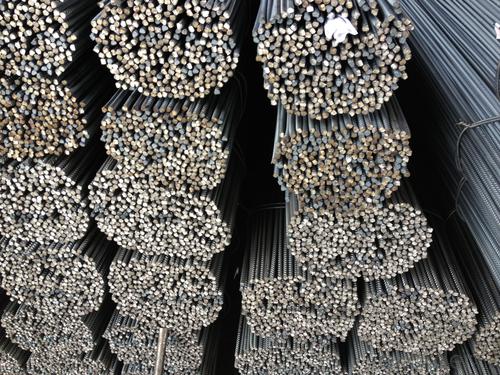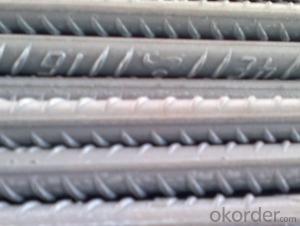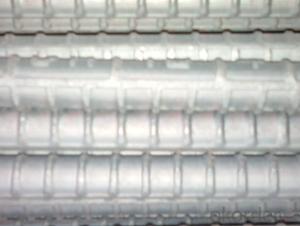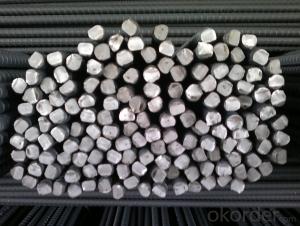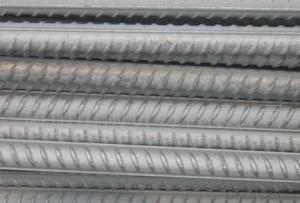Hot Rolled Deformed Steel Rebars ASTM GR40, GR60
- Loading Port:
- Shanghai
- Payment Terms:
- TT or LC
- Min Order Qty:
- 100 m.t.
- Supply Capability:
- 200000 m.t./month
OKorder Service Pledge
OKorder Financial Service
You Might Also Like
OKorder is offering Hot Rolled Deformed Steel Rebars ASTM GR40, GR60 at great prices with worldwide shipping. Our supplier is a world-class manufacturer of steel, with our products utilized the world over. OKorder annually supplies products to African, South American and Asian markets. We provide quotations within 24 hours of receiving an inquiry and guarantee competitive prices.
Product Applications:
Hot Rolled Deformed Steel Rebars ASTM GR40, GR60 are ideal for structural applications and are widely used in the construction of buildings and bridges, and the manufacturing, petrochemical, and transportation industries.
Product Advantages:
OKorder's Hot Rolled Deformed Steel Rebars ASTM GR40, GR60 are durable, strong, and wide variety of sizes.
Main Product Features:
· Premium quality
· Prompt delivery & seaworthy packing (30 days after receiving deposit)
· Can be recycled and reused
· Mill test certification
· Professional Service
· Competitive pricing
Product Specifications:
Manufacture: Hot rolled
Grade: Gr40,Gr60 etc
Certificates: ISO, SGS, BV, CIQ
Length: 6m – 12m, as per customer request
Packaging: Export packing, nude packing, bundled
Deformed Steel Bar | ||
Diameter (MM) | Cross Sectional Area (MM2) | Theorectical Weight (KG/M) |
6 | 28.27 | 0.222 |
8 | 50.27 | 0.395 |
10 | 78.54 | 0.617 |
12 | 113.1 | 0.888 |
14 | 153.9 | 1.21 |
16 | 201.1 | 1.58 |
18 | 254.5 | 2 |
20 | 314.2 | 2.47 |
22 | 380.1 | 2.98 |
25 | 490.9 | 3.85 |
28 | 615.8 | 4.83 |
32 | 804.2 | 6.31 |
36 | 1018 | 7.99 |
40 | 1257 | 9.87 |
FAQ:
Q1: Why buy Materials & Equipment from OKorder.com?
A1: All products offered byOKorder.com are carefully selected from China's most reliable manufacturing enterprises. Through its ISO certifications, OKorder.com adheres to the highest standards and a commitment to supply chain safety and customer satisfaction.
Q2: How do we guarantee the quality of our products?
A2: We have established an advanced quality management system which conducts strict quality tests at every step, from raw materials to the final product. At the same time, we provide extensive follow-up service assurances as required.
Q3: what is the difference between actual weight and theoretical weight?
A3: All the section steel has two weights: actual weight and theoretical weight. Actual weight is the weighing out when the product delivered from the mill. Theoretical weight is calculated by pieces. The invoice can be based on each of them as your request.
Images:


- Q: Can steel rebars be used in seismic-resistant construction?
- Yes, steel rebars can be used in seismic-resistant construction. Steel rebars are commonly employed in reinforced concrete structures to enhance their strength and ductility, making them more capable of withstanding seismic forces. The use of properly designed and installed steel rebars helps to improve the overall structural integrity and stability of buildings in earthquake-prone areas.
- Q: Are there any limitations in using steel rebars in construction?
- Yes, there are limitations in using steel rebars in construction. Some limitations include susceptibility to corrosion in certain environments, high thermal conductivity, and potential for expansion or contraction due to temperature changes. Additionally, steel rebars have a relatively high weight, which can make transportation and installation more challenging. However, these limitations can be mitigated through proper design, material selection, and maintenance strategies.
- Q: Are there any limitations on the maximum length of steel rebars in construction?
- Yes, there are limitations on the maximum length of steel rebars in construction. The length is typically determined by practical considerations such as transportation, handling, and installation constraints. Additionally, longer rebars may be subject to bending or flexing, which can affect their structural integrity. Therefore, industry standards and building codes often specify maximum lengths for steel rebars to ensure safe and efficient construction practices.
- Q: Can steel rebars be used in the construction of shopping malls and commercial buildings?
- Yes, steel rebars can be used in the construction of shopping malls and commercial buildings. Steel rebars are commonly used as reinforcement in concrete structures to enhance their strength and durability. Due to their high tensile strength and ability to withstand heavy loads, steel rebars provide structural stability and help prevent cracking and collapse in large-scale constructions like shopping malls and commercial buildings.
- Q: Can steel rebars be used in the construction of hospitals?
- Yes, steel rebars can be used in the construction of hospitals. Steel rebars are commonly used in reinforced concrete structures to provide strength and stability. In hospital construction, where safety and durability are crucial, steel rebars are essential for reinforcing concrete foundations, columns, beams, and other structural elements. They help ensure the structural integrity of the hospital building, making it resilient and capable of withstanding various loads and potential hazards.
- Q: Can steel rebars be used in buildings with high architectural requirements?
- Yes, steel rebars can be used in buildings with high architectural requirements. Steel rebars provide the necessary strength and structural integrity required for such buildings, while also allowing for flexibility in design and construction. They can be easily shaped and bent to meet specific architectural demands, ensuring both functionality and aesthetic appeal in the building's design.
- Q: What is the difference between steel rebars and FRP rebars?
- Steel rebars and FRP rebars are two different materials used for reinforcement in construction projects. The main difference between steel rebars and FRP (Fiber Reinforced Polymer) rebars lies in their composition and mechanical properties. Steel rebars are made of carbon steel and are known for their high tensile strength and durability. They have been widely used in construction for many years and are a reliable choice for reinforcing concrete structures. On the other hand, FRP rebars are made of fibers, such as glass or carbon, embedded in a polymer matrix. This composite material offers several advantages over steel rebars. Firstly, FRP rebars are lighter in weight, making them easier to handle and transport. This can reduce labor and equipment costs during construction. Secondly, FRP rebars are non-corrosive, unlike steel rebars. Steel rebars are prone to corrosion when exposed to moisture and chemicals, which can weaken the structure over time. FRP rebars do not rust or corrode, making them ideal for environments with high humidity, saltwater, or chemical exposure. Another significant difference is that FRP rebars have a high resistance to electromagnetic fields. This makes them suitable for applications in sensitive areas, such as hospitals, power plants, or telecommunication facilities, where electromagnetic interference should be minimized. However, there are also some limitations to consider with FRP rebars. They have lower tensile strength compared to steel rebars, which means they may not be suitable for heavy-load-bearing structures. Additionally, FRP rebars have a higher initial cost compared to steel rebars, although this can be offset by their long-term durability and reduced maintenance requirements. In summary, the main differences between steel rebars and FRP rebars lie in their composition, mechanical properties, and performance in different environmental conditions. Steel rebars offer high tensile strength but are vulnerable to corrosion, while FRP rebars are lighter, non-corrosive, and have a high resistance to electromagnetic fields. The choice between the two depends on the specific project requirements, load-bearing needs, and environmental factors.
- Q: What is the role of steel rebars in preventing structural failures?
- The role of steel rebars in preventing structural failures is crucial and integral in the construction industry. Steel rebars, also known as reinforcing bars, are used to reinforce and strengthen concrete structures, ensuring their durability and ability to withstand various forces. One of the primary functions of steel rebars is to enhance the tensile strength of concrete. While concrete is an excellent material for compression, it is relatively weak in tension. The introduction of steel rebars into concrete structures helps to counter this weakness by providing resistance to tensile forces. Steel rebars act as a reinforcement, absorbing and distributing tensile stresses throughout the structure, preventing cracks and fractures from developing and ultimately preventing structural failures. Additionally, steel rebars play a crucial role in preventing structural failures by improving the overall structural stability. By reinforcing concrete, rebars enhance the structural integrity and increase the load-bearing capacity of the structure. This allows the structure to withstand heavier loads and forces, such as those caused by natural disasters, extreme weather conditions, or human activities. Steel rebars are also essential in preventing structural failures caused by corrosion. Concrete structures are exposed to various environmental factors that can lead to corrosion of the reinforcing steel, such as moisture, chemicals, and salts. As steel rebars are typically coated or protected with anti-corrosive materials, they provide a barrier against corrosion, ensuring the long-term durability and integrity of the structure. Furthermore, steel rebars aid in preventing structural failures by providing stability during construction. During the construction process, steel rebars are strategically placed within the concrete forms to provide reinforcement at critical points and areas prone to high stress. This ensures that the structure is stable and can withstand the loads and forces imposed during and after construction. In summary, the role of steel rebars in preventing structural failures is multi-faceted. They enhance the tensile strength of concrete, increase structural stability, prevent corrosion, and provide stability during construction. By reinforcing the concrete, steel rebars significantly contribute to the overall strength, durability, and safety of structures, ultimately preventing structural failures and ensuring the longevity of the built environment.
- Q: Like a steel rebar and wire spiral, is the same? What's the difference?
- The difference is that there are different ways of supplying. One is straight supply, the other is supplied by diskHalf of the price slightly lower than the straight, use less material processing to zero, but more a process.
- Q: Can steel rebars be used in foundation construction?
- Yes, steel rebars can be used in foundation construction. Steel rebars are commonly used to reinforce concrete structures, including foundations, to provide additional strength and durability. They help to prevent cracking and improve the overall stability of the foundation.
Send your message to us
Hot Rolled Deformed Steel Rebars ASTM GR40, GR60
- Loading Port:
- Shanghai
- Payment Terms:
- TT or LC
- Min Order Qty:
- 100 m.t.
- Supply Capability:
- 200000 m.t./month
OKorder Service Pledge
OKorder Financial Service
Similar products
Hot products
Hot Searches
Related keywords



